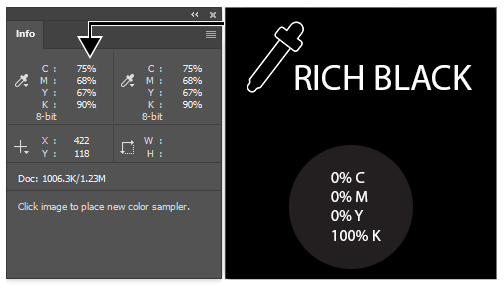Rich Black vs. 100% K Black
How Black Are Your Blacks?
If you've ever printed a color version of a flyer and compared it to a black-and-white version of the exact same file, you may notice something strange on the B&W copy...
"These blacks aren't black enough!"
This makes no sense, right? If something is black in your color flyer, it should be just as black on your B&W flyer too, should it not? Black is black. Right??
Well, not exactly...
The blacks in your color file are probably what's called "Rich Black." Normal digital printers use CMYK color profiles (Cyan, Magenta, Yellow, Black). When you print on a black and white machine, K (black) is the only toner color in the machine. But when you print color files with Rich Black on a color machine, that perceived blackness is actually a combination of K (black) as well as lesser values of Cyan, Magenta and Yellow. This gives it a deeper, more solid consistency which cannot be achieved with just 100% K toner.

This is somewhat reflective of the science of color and light as we perceive them. Black objects are not inherently black, but rather, they absorb all the colors of the visible light spectrum, reflecting none of them back at our eyes.
This differs from the blackness in the night sky, or in a room with no lights or windows, which is defined by the absence of light. But since computer screens use light to project images, Rich Black cannot be achieved by subtractive methods alone (removing all light) and is instead achieved by an additive process (combining colors of light).
"How can I get the blackest black possible with B&W printing?"
If you're converting a file from color to grayscale for black and white printing, make sure that the K value of your dark blacks are ~100% K after converting. Some rich blacks are composed of less than 100% of each color value, so when you discard the color information, the black may render at an opacity equivalent to its original K value. For example, a black tone in a color file which is composed of 75% C, 75% M, 75% Y, 75% K, will only be 75% K when you discard the C, M and Y. That means on a grayscale between 0% (white) and 100% (black), your blacks will be reduced in darkness (gray) by 25%.
Some software, like Acrobat and Photoshop, will automatically adjust the K values to make up for the lost darkness (to the degree which it can) when converting from color to grayscale, but custom settings in your program may affect this. If your blacks still look good on screen after converting to grayscale, they should look decent when printed as well. But if you want the richest blacks possible, design in rich black and print in color.
 Processing...
Processing...